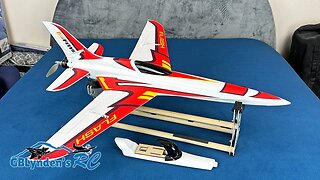Boeing B-17 Flying Fortress Sentimental Journey Taxi and Up Close Look in Bellingham, WA
This video shows footage I took of the Boeing B-17 Flying Fortress Sentimental Journey when it was in Bellingham, Washington a while back of one of the most influential bomber of the war the Greatest Generation fought and won. This made it a very important WWII bomber. This is the same type of plane that was shown in the Hollywood movie about the flying fortress Memphis Belle.
I took footage of its taxi as well as some up close shots with its four huge props nearly blowing me over. I later saw a WWII Warbird in the form of a North American P-51 Mustang that was also a part of the Allied Forces in World War Two. It was part of the protection on the wings of the Boeing B-17 Bomber.
My new E-flite P-51 Mustang flies much like the Mustang I saw that day. It is very dynamic in the sky and sexy. I had a great day that day and I will never forget it actually.
This experience is also one of the reasons why I decided to purchase my new E-flite UMX B-17 Flying Fortress WWII Bomber. It flies like crap compared to this, but at least it looks cool :)
Really the only thing missing from this event is an F4U Corsair like my Parkzone F4U Corsair or Parkzone Corsair.
The Boeing B-17 Flying Fortress is a four-engine heavy bomber aircraft developed in the 1930s for the United States Army Air Corps (USAAC). Competing against Douglas and Martin for a contract to build 200 bombers, the Boeing entry outperformed both competitors and more than met the Air Corps' expectations. Although Boeing lost the contract because the prototype crashed, the Air Corps was so impressed with Boeing's design that they ordered 13 more B-17s for further evaluation. From its introduction in 1938, the B-17 Flying Fortress evolved through numerous design advances.
The B-17 was primarily employed by the United States Army Air Forces (USAAF) in the daylight precision strategic bombing campaign of World War II against German industrial and military targets. The United States Eighth Air Force, based at many airfields in southern England, and the Fifteenth Air Force, based in Italy, complemented the RAF Bomber Command's nighttime area bombing in the Combined Bomber Offensive to help secure air superiority over the cities, factories and battlefields of Western Europe in preparation for the invasion of France in 1944.[4] The B-17 also participated to a lesser extent in the War in the Pacific, early in World War II, where it conducted raids against Japanese shipping and airfields.
From its pre-war inception, the USAAC (later USAAF) touted the aircraft as a strategic weapon; it was a potent, high-flying, long-range bomber that was able to defend itself, and to return home despite extensive battle damage. It quickly took on mythic proportions,[5][6] and widely circulated stories and photos of notable numbers and examples of B-17s surviving battle damage increased its iconic status.[7] With a service ceiling greater than any of its Allied contemporaries, the B-17 established itself as an effective weapons system, dropping more bombs than any other U.S. aircraft in World War II. Of the 1.5 million metric tons of bombs dropped on Germany and its occupied territories by U.S. aircraft, 640,000 tons were dropped from B-17s.[8]
As of September 2011, 13 aircraft remain airworthy, with dozens more in storage or on static display.
-
 5:03
5:03
GBLynden's RC
8 months ago112MPH FMS Flash 850mm RC Speed Plane | Unboxing & Overview
105 -
 2:26:44
2:26:44
Mally_Mouse
7 hours agoLet's Play -- Crowd Control Minecraft
24.4K4 -
 2:19:18
2:19:18
The Quartering
12 hours agoTrump Mistrial Bombshell, RNC Plans For Trump In Jail & Maybe Some Video Games
58.8K141 -
 3:10:32
3:10:32
SNEAKO
12 hours agoIs Trump a Criminal?
98K68 -
 2:22:40
2:22:40
Jewels Jones Live ®
1 day agoTHE ART OF LAWFARE | A Political Rendezvous - Ep. 79
66.2K32 -
 25:30
25:30
Stephen Gardner
1 day ago🔴BREAKING: Trump MISTRIAL details | George Clooney's Netanyahu SECRET LEAKS!!
82K433 -
 1:18:43
1:18:43
Kim Iversen
1 day agoAmbassador Chas Freeman "Israel Has Never Put Forward A Peace Proposal"
95.6K212 -
 48:34
48:34
Breaking Points
2 days agoMAGA Lawyer DEBATES Liberal Analyst On Trump Legal Cases
66.6K57 -
 19:09
19:09
Scammer Payback
4 days agoConfronting Scammer Payback Imposters
120K40 -
 9:07
9:07
shaneyyricch
1 day agoAddressing my beef with Harry Sisson
110K113